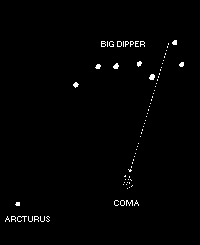COMA BERENICES
Jack Schmidling Productions, Inc.
At a distance of about 250 light years, the Coma group is one of the nearest of all
star clusters. There are about 40 members all traveling as a group.
Being "visible to the naked eye" requires a bit of explanation in these days
of rampant artificial lighting and the light pollution it causes. When the
constellation was named in the "good old days" it was very conspicuous
and demanded a name but would not even be noticed by the average
person today.
Seeing it requires a fairly dark sky and a knowledge of where to look.
Look for a fuzzy patch about 5 times as large as the Moon. A
pair of binoculars is a big help and provides a beautiful view even if you
can not see it with the naked eye. My guess is that is about what it
looked like to the ancients who had no optical aid.
One other point, we can not blame man for moonlight but it is just as
devastating to dim objects as artificial lights so don't even bother trying
to find it when the moon is out.
Technical Details of photo:
For the most recent Astrophotos of the Week...
RECENT PHOTOS
18016 Church Road ~ Marengo IL 60152
ASTRONOMY PAGE
HOME PAGE COMA BERENICES
(Berenice's Hair)
While not a show stopper, Coma Berenices is interesting for several
reasons, not the least of which is the fact that it is one of the few star
clusters visible to the naked eye.

Coma Berenices Star Cluster
Ancient legend has it that Berenices, queen of Egypt, pledged her golden tresses
if her husband returned safely from a battle. He did and the gods placed her hair high
in the Spring sky for all the world to see.

Coma Cluster Finder Chart
Assuming you can find the Big Dipper, Coma Berenices will be found by
more or less tracing a line down from the two diagonal stars in the cup of
the dipper. The stars in the handle trace down to Arcturus and Coma lies
in the area indicated between it and the dipper.
This was a 30 minute exposure on hypered Techpan taken with a 135 mm
camera lens mounted in a 4 x 5" AstroCamera.